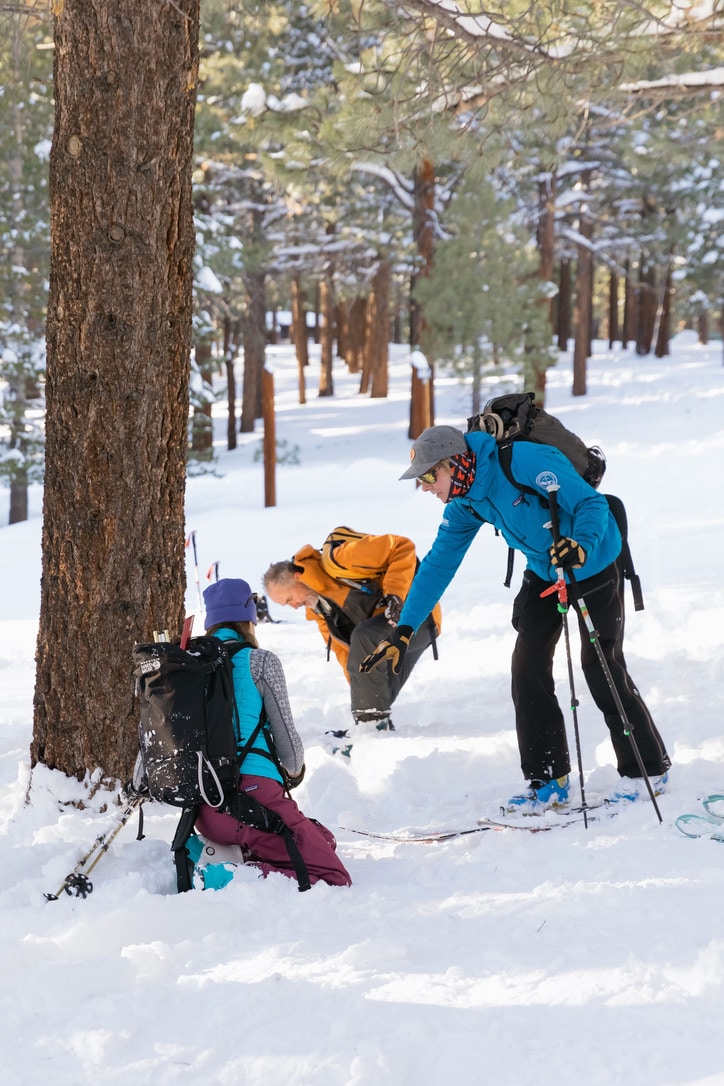Submission by Trevor Husted
The memory is vivid, it started with a hollow thump that turned into a heavy roar. The sound dissipated as quickly as it started and when our group of backcountry splitboarders arrived at the ridge we looked over to the next slope and saw that the whole slope of snow had ripped away in chunks that tore out all the way to the ground. It was my first real encounter with an avalanche and I distinctly remember the carnage and the force. Trees were carried from their homes and the avalanche crown was at least 5 feet high. The experience was unforgettable and was a good reminder of the inherent risk that is involved with backcountry skiing and riding.
For enthusiasts who enjoy skiing and snowboarding within resort boundaries, the idea of an avalanche may not even be a thought yet for those looking to venture into the snowy backcountry landscapes, the idea of getting out there may be intimidating or even scary. For those aspiring to be backcountry skiers and riders, a little bit of information can help us challenge preconceptions of how we see the backcountry. Fortunately for us, there are a variety of tools that we can use in the backcountry to assist in building a solid foundation around education.
So where does one seeking to get out into the backcountry start? Going out with an experienced friend? Learning how to use an avalanche transceiver? Binge-watching Cody Townsend’s quest to ski the 50 Classic Ski Descents in North America with the Fifty? While these are all good starting points, there is nothing like getting the hands-on experience of enrolling in and taking an avalanche course.
What is an Avalanche Course and Why is it Important?
In the realm of backcountry skiing and riding, knowledge equates to power (as with many things in life) and one of the most effective ways to gather that knowledge can be through an Avalanche Course. Through taking an avalanche course students will gain the knowledge and the skills to be able to make effective and safe decisions while recreating in and around avalanche terrain. The curriculum follows the core principles presented through The American Institute for Avalanche Research and Education (AIARE). The three different recreational courses (Recreational 1, Avalanche Rescue Course, and Recreational 2) follow a format based on Preparation, Planning, Riding Safely, Teamwork, and the importance of Debriefing. Below we go more in-depth on the three main recreational courses.
AIARE Recreational 1
This two-day hybrid breaks down the decision-making process and teaches participants how to manage risk in a backcountry environment. Students will learn about how to create efficient travel plans through avalanche terrain, read and understand avalanche forecasts, and will become more proficient in learning to identify avalanche terrain. The course will also help students gain the skills needed to perform a rescue and will become more confident in utilizing backcountry equipment in the field. In practicing these skills, participants will have a better understanding of how to be more confident and independent backcountry skiers/riders, which will also benefit their teams and/or backcountry partner(s).
AIARE Avalanche Rescue
The AIARE rescue course is a crucial component in learning to become proficient in rescue if an avalanche event were to occur. The course will take students through multiple scenarios and will teach the participants how to effectively perform a rescue. Participants will also learn to become familiar with their rescue equipment and through practice will improve response times and skills. In systemically learning these skills students will better understand and demonstrate how to react and search in a high-stress, life-or-death situation.
AIARE Recreational 2
For those advanced students who have already taken the AIARE 1, the AIARE Rec 2 is a great way to further advance and build on the skills previously gained. Students will dive into continuing to learn and interpret information gathered through reading an avalanche report, the weather forecast, and through making observations in the field. They will also learn to grow their leadership skills while working within a small team to help to reduce risk, effectively choose appropriate terrain to ski and travel through as well as facilitate constructive conversations with team members to make calculated decisions. This course is an excellent way for students to continue to grow skills and further build independence in the backcountry.
The importance of gaining avalanche education is such a beneficial skill that will help ensure that you have the skills to potentially save someone’s life while also gaining the assurance of knowing how to practice safety in the backcountry. Whether you are thinking about making the jump from the resort to the backcountry or are just looking to get a fresh start and take advantage of the joys of continuing to explore nature and fresh powder, consider making the investment in education and acquiring lifelong skills that in turn will make safely navigating through the mountains more accessible.
